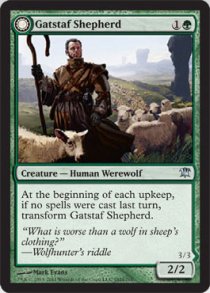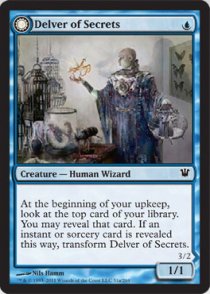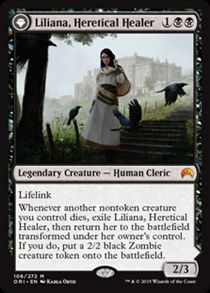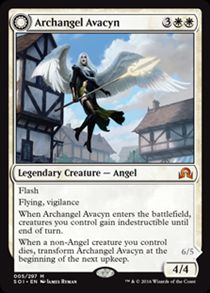Double-faced kaarten (of DFC voor het gemak) kwamen voor het eerst voor in Innistrad, werden gebruikt voor de 5 Planeswalkers in Magic Origins  en zitten nu weer volop in Shadows over Innistrad en zitten nu weer volop in Shadows over Innistrad  ! De kaarten werken eigenlijk heel simpel en intuïtief: er staat op wanneer je ze mag omdraaien, je negeert volledig wat op de onzichtbare kant staat, en na transformatie is het nog steeds hetzelfde permanent als ervoor (dus alle dingen zoals aura's, equipment en gemarkeerde damage blijven er op liggen). Met deze informatie kom je er in 99% van de gevallen wel uit, maar helaas was het flink ingewikkeld om alles (inclusief de corner cases) werkend te krijgen in de regels. Daarom hieronder een flinke lap tekst in het Engels waarin de details uitgelegd staan, maar die kun je eigenlijk meestal negeren en is voornamelijk bedoeld als naslagwerk voor de 1% waarin de basisregel je niet verder helpt. Heb je nog vragen? Stuur een van de Rules Guru Mods (Dustin, Arjan, LotZ, Xander) een berichtje of post je vragen in het regelvragen forum! ! De kaarten werken eigenlijk heel simpel en intuïtief: er staat op wanneer je ze mag omdraaien, je negeert volledig wat op de onzichtbare kant staat, en na transformatie is het nog steeds hetzelfde permanent als ervoor (dus alle dingen zoals aura's, equipment en gemarkeerde damage blijven er op liggen). Met deze informatie kom je er in 99% van de gevallen wel uit, maar helaas was het flink ingewikkeld om alles (inclusief de corner cases) werkend te krijgen in de regels. Daarom hieronder een flinke lap tekst in het Engels waarin de details uitgelegd staan, maar die kun je eigenlijk meestal negeren en is voornamelijk bedoeld als naslagwerk voor de 1% waarin de basisregel je niet verder helpt. Heb je nog vragen? Stuur een van de Rules Guru Mods (Dustin, Arjan, LotZ, Xander) een berichtje of post je vragen in het regelvragen forum!
Double-faced cards originally appeared in the Innistrad™ block, and they return in the Shadows over Innistrad set. Instead of the typical card face and Magic card back, double-faced cards have two faces: a front face and a back face. The front face has a sun symbol in its upper left corner. The back face has a moon symbol in its upper left corner. Other than distinguishing one face from the other, these symbols have no effect on game play.
Though most of the rules governing double-faced cards haven't changed, you can find a few minor revisions in the section titled "Rules Changes: Double-Faced Cards." The following rules have remained the same:
* Each face of a double-faced card has its own set of characteristics: name, types, subtypes, abilities, and so on. While a double-faced card is on the battlefield, consider only the characteristics of the face that's currently up. The other set of characteristics is ignored.
* While a double-faced card isn't on the battlefield, consider only the characteristics of its front face. For example, the above card has only the characteristics of Aberrant Researcher in the graveyard, even if it was Perfected Form on the battlefield before it was put into the graveyard.
* The converted mana cost of a double-faced card not on the battlefield is the converted mana cost of its front face.
* The back face of a double-faced card may have a color indicator that defines its color. For example, Perfected Form is a blue permanent.
* The back face of a double-faced card can't be cast.
* A double-faced card enters the battlefield with its front face up by default, unless a spell or ability instructs you to put it onto the battlefield transformed, in which case it enters with its back face up.
* Transforming a permanent doesn't affect any Auras or Equipment attached to that permanent. Similarly, any counters on the permanent will remain on that permanent after it transforms. Any continuous effects from a resolved spell or ability will continue to affect it.
* Damage marked on a double-faced permanent will stay marked on that permanent after it transforms.
-----
Rules Changes: Double-Faced Cards
There are three new rules that affect how double-faced cards work.
202.3b The converted mana cost of a double-faced permanent's back face is calculated as though it had the mana cost of its front face. This is a change from previous rules. If a permanent is copying the back face of a double-faced card (even if the card representing that copy is itself a double-faced card), the converted mana cost of that permanent is 0.
* For example, Krallenhorde Howler is the back face of Duskwatch Recruiter, which has mana cost {1}{G}. Krallenhorde Howler's converted mana cost is 2.
* A creature that's a copy of Krallenhorde Howler will have converted mana cost 0. Note that a creature that's a copy of Duskwatch Recruiter also has mana cost {1}{G}, and thus has converted mana cost 2.
711.7a If a player is instructed to put a non-double-faced card onto the battlefield transformed, that card stays in its current zone. This is a change from previous rules.
* For example, say a card that isn't a double-faced card (such as Altered Ego) is a copy of a card with an ability that may return it to the battlefield transformed (such as Accursed Witch). When that copy dies, the triggered ability that tries to return it to the battlefield transformed will have no effect. The card will remain in its owner's graveyard.
701.25e If an activated ability of a permanent tries to transform that permanent, the permanent transforms only if it hasn't transformed since the ability was put onto the stack. The same is true for triggered abilities of a permanent that aren't delayed triggered abilities. If a delayed triggered ability of a permanent tries to transform that permanent, the permanent transforms only if it hasn't transformed since that delayed triggered ability was created.
* For example, if you choose to activate the ability of Elusive Tormentor (a creature with the ability "{1}, Discard a card: Transform Elusive Tormentor") four times in response to one another, the first ability to resolve will cause it to transform and the other three instances of the ability will have no effect.
-----
Game Supplement: Checklist Cards
It's important that the cards in your deck be indistinguishable from one another. To accomplish this with double-faced cards, you can use the checklist cards found in some Shadows over Innistrad booster packs. A checklist card acts as a substitute for a double-faced card in hidden zones or wherever its identity is concealed (such as in exile if it's exiled face down). Using checklist cards is optional, but in tournaments, players with double-faced cards must use either checklist cards or opaque card sleeves (or both).
* There are two checklist cards for the double-faced cards in Shadows over Innistrad: one for common and uncommon cards and one for rare and mythic rare cards. You'll need the correct checklist cards for the double-faced cards you wish to play.
* You must have the actual double-faced card the checklist card is representing with you. The double-faced card should be kept apart from the rest of the deck and your sideboard.
* A checklist card can't be included in a deck except when it's being used to represent a double-faced card.
* You must clearly mark exactly one circle on the checklist card to indicate which double-faced card it represents.
* During the game, a checklist card is considered to be the double-faced card it represents.
* If a checklist card enters a public zone (the battlefield, the graveyard, the stack, or exile unless it's exiled face down), use the actual double-faced card and set the checklist card aside. If the double-faced card is put into a hidden zone (your hand or library), use the checklist card again.
* If a double-faced card is exiled face down or put onto the battlefield face down, keep its identity hidden by using the face-down checklist card or opaque card sleeves (or both).
-----
|











